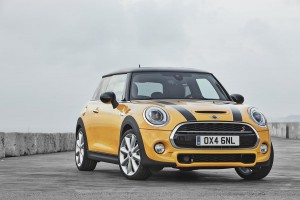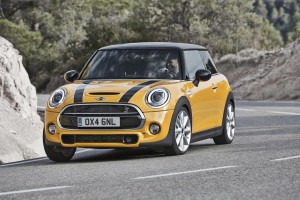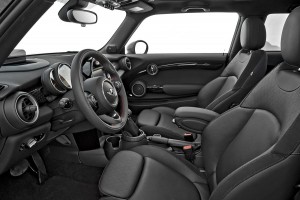
BMW has taken the wraps off the third generation of Mini developed under its ownership.
The new F56-generation three-door hatchback has evolutionary styling, increased dimensions, a host of new technology and, most important, a new platform and a range of new three-cylinder engines that will also be used in BMW models.
The new Mini was unveiled at the firm’s Oxford factory today before simultaneous motor show unveilings at the Tokyo motor show and LA motor show. It will go on sale in the UK next spring, with the initial range of Cooper, Cooper D and Cooper S models priced from £15,300.
Mini calls the new model “completely new from the ground up”, the result of which is “a Mini that is distinctly familiar but enhanced in every single way”.
The new Mini is 3821 mm long, 1727 mm wide and 1414 mm high. That’s 98 mm longer, 44 mm wider and 7 mm taller than its predecessor. The wheelbase is up by 42 mm to 2495 mm and track widths increase by 42 mm at the front and 34 mm at the rear. The result of these increased dimensions is improved cabin space. Boot space is also up 30 per cent to 211 litres.

The all-new engine line-up at launch features a 1.5-litre three-cylinder petrol unit in the Cooper, a 1.5-litre three-cylinder diesel in the Cooper D and a 2.0-litre four-cylinder petrol in the Cooper S.
Each engine is turbocharged, has a stop-start system, complies with Euro 6 emissions regulations, offers peak power and torque lower in the rev range than its predecessor and is up to 27 per cent more fuel efficient than the engine that it replaces.
The £15,300 Cooper has outputs of 134 bhp and 162 lb ft. Its combined economy is 62.8 mpg and CO2 emissions are 105 g/km. The £16,450 Cooper D’s figures are 114 bhp , 199 lb ft, 80.7 mpg and 92 g/km. For the r ange-topping, £18,650 Cooper S, they are 189 bhp, 206 lb ft, 49.6 mpg and 133 g/km.
Three all-new transmissions in the front-wheel-drive model are offered. A six-speed manual is standard, and it comes with a rev-matching system on downshifts. A six-speed automatic is optional on all models. This increases CO2 emissions, but it still dips below 100 g/km in the Cooper D auto, with a figure of 98 g/km. A sports version of the auto is also optional, with shorter shift times, paddle shifters and rev matching on downshifts.
Mini has yet to confirm other engines, but lower-powered triples in the One and One D are likely to follow later in 2014, as well as a higher-powered diesel for the Cooper SD and a more potent version of the Cooper S’s engine in the JCW.
Underpinning the third-gen Mini is a new BMW-engineered platform called UKL1. It will be used to underpin the entire new Mini range, as well as a suite of new front-wheel-drive BMWs, starting with the 2-series Active Tourer mini-MPV, which is due on sale in the UK next summer after being unveiled at the Geneva motor show in March.
The platform will be available in various different wheelbase lengths and track widths. It will support all-wheel drive and various hybrid and electric drivetrains. MacPherson strut suspension features at the front, with a new version of BMW’s Z-axle multi-link set-up at the rear.

The use of aluminium and high-strength steel in the suspension reduces weight and improves rigidity, according to Mini, and results in “intensified” handling, improved acoustic refinement and fewer road vibrations. Extensive testing of the new car, which weighs 1085kg in base Cooper form, has taken place on UK roads.
Variable Damper Control is optional, the first time that adaptive dampers have been offered on a Mini. These offer two set-ups: Comfort and Sport. The Cooper and Cooper D ride on 15-inch alloy wheels as standard. The Cooper S sits on 16s. Alloys of up to 18 inches are on the options list.
The design is instantly recognisable as a ‘new’ Mini, with more distinctive front and rear ends and sharper creases in the bodywork. The proportions have altered slightly due to the increased dimensions and front overhang caused by the adoption of the UKL1 platform.
The split front grille is much larger at the top and a more sculpted front bumper is adopted. The larger circular headlights feature a ring of LED lights, something inspired by the Rocketman concept from 2011. Full LED headlights feature for the first time in the segment.
In profile, the roofline tapers down slightly towards the rear and the waistline slightly up for a wedge-shaped look, akin to the Mini Paceman. At the rear, the evolved look includes new LED rear light clusters.
Mini claims that the increased size allows space for four adults and their luggage. The footwells are larger and there is more shoulder room for passengers, as well as bigger front seats with greater adjustability. The rear bench can be split 60/40. It also features tilt adjustment when an optional storage pack is specified.
The design of interior is also recognisable as a Mini, albeit one with a more mature look and higher-quality materials. The circular theme remains, not least on the centre console, which features a screen of up to 8.8 inches in size to display all the infotainment. This is controlled via a choice of two BMW iDrive-style controllers.
Most of the key driver information, including the analogue speedometer, has shifted from the large central display and directly into the driver’s eyeline.
Another notable feature is the rehousing of the electric front window switches in the door trims from the toggles at the base of the centre console.
The extensive options list includes a host of personalisation, comfort, connectivity, convenience and driver-assistance features.